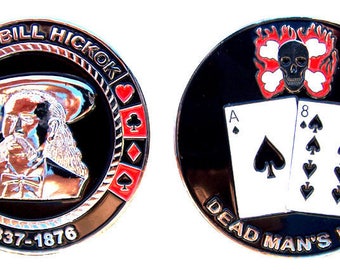The Infamous ‘Dead Man’s Hand’ And Its History in The Poker Game Before he became a lawman, Wild Bill Hickok was one of the most skilled poker players of his era. By jacksadmin February 25, 2019, 2:14 pm 282 Views.
James Butler Hickok was born in Troy Grove, Illinois, on May 27th, 1837. After his parents, William Alonzo Hickok and Polly Butler got married, they decided to move to Illinois and start a family.
Over the span of twelve years, they had seven children: five boys and two girls. James Hickok better known today as, Wild Bill Hickok, was the youngest boy of the family.
He got his entire family involved but his association with the group came to an end the moment his father passed away. Hickok was only seventeen years old at the time and it motivated him to take a move to Utica, Illinois in hopes of having a better life.
He ended up working as a wagon driver on the Illinois and Michigan Canal but he was quickly let go from his position for mistreating the horses, even though he swore that he never did.

About two years after Hickok had moved away from his family, his brother Lorenzo decided to join up with him. They headed to the Kansas territory to meet up with other progressive groups that had a passion for abolishing slavery.

The makeup of poker's dead man's hand has varied through the years. Currently, it is described as a two-pairpoker hand consisting of the black aces and black eights. These, and an unknown hole card, were reportedly held by Old Westfolk hero, lawman, and gunfighterWild Bill Hickok when he was murdered while playing a game. No contemporaneous source records the exact cards he held when killed. Frank Wilstach's 1926 book, Wild Bill Hickok: The Prince of Pistoleers, led to the popular modern conception of the poker hand's contents.
Earliest details[edit]
The expression 'dead man's hand' appears to have had some currency in the late 19th and early 20th centuries, although no one connected it to Hickok until the 1920s.[1] The earliest detailed reference to it was 1886, where it was described as a 'full house consisting of three jacks and a pair of tens'.[2] Jacks and sevens are called the dead man's hand in the 1903 Encyclopaedia of Superstitions, Folklore, and the Occult Sciences.[3]Edmond Hoyle refers to it as Jacks and eights in 1907.[4]
Hickok's hand[edit]
Wild Bill Hickok Card Hand
What is considered the dead man's hand card combination of today gets its notoriety from a legend that it was the five-card stud hand held by James Butler Hickok (better known as 'Wild Bill' Hickok) when he was shot in the back of the head by Jack McCall on August 2, 1876, in Nuttal & Mann's Saloon at Deadwood, Dakota Territory. Reportedly, Hickok's final hand included the aces and eights of both black suits.[5]
According to a book by Western historian Carl W. Breihan, the cards were retrieved from the floor by a man named Neil Christy, who then passed them on to his son. The son, in turn, told Mr. Breihan of the composition of the hand. 'Here is an exact identity of these cards as told to me by Christy's son: the ace of diamonds with a heel mark on it; the ace of clubs; the two black eights, clubs and spades, and the queen of hearts with a small drop of Hickok's blood on it.'[6]
Hickok biographer Joseph Rosa wrote about the make-up of the hand: 'The accepted version is that the cards were the ace of spades, the ace of clubs, two black eights, and the queen of clubs as the 'kicker'.'[7] However, Rosa said that no contemporaneous source can be found for this exact hand.[8] The solidification in gamers' parlance of the dead man's hand as two pairs, aces and eights, did not come about until after the 1926 publication of Frank Wilstach's book Wild Bill Hickok: The Prince of Pistoleers—50 years after Hickok's death.[1]
Wild Bill Hickok Pictures Of His Death
Legacy[edit]

The Las Vegas Metropolitan Police Department Homicide Division, the Los Angeles Police Department CRASH squad, and the Armed Forces Medical Examiner System all use the dead man's hand in their insignia.[9][10]
See also[edit]
References[edit]
Wild Bill Hickok Wiki
- ^ ab'Was Wild Bill Hickok Holding the Dead Mans Hand When He Was Slain; The Straight Dope article; retrieved March 2013.
- ^DiscussionArchived 2007-10-20 at the Wayback Machine; July 3, 1886, article in the Grand Forks Daily Herald; at Linguist List online; retrieved February 2013.
- ^Cora Linn Morrison Daniels, et al; editor; Volume 2.
- ^Edmond Hoyle; Hoyle's Games; 1907; p. 405
- ^Wild Bill Hickok: The Prince of Pistoleers; Frank J. Wilstach; 1926.
- ^Wild Women of the West; Signet; 1982; p. 77.
- ^Wild Bill Hickok: Gunfighter; Joseph G. Rosa; p. 163.
- ^Wild Bill Hickok: The Man and his Myth; Joseph Rosa; 1996.
- ^'Las Vegas Metropolitan Police Department'. Archived from the original on 16 March 2015. Retrieved 20 March 2015.
- ^'Office of the Armed Forces Medical Examiner'. Archived from the original on 15 May 2012. Retrieved 20 March 2015.